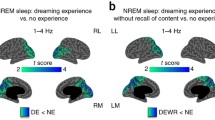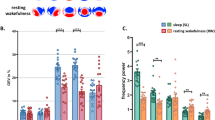Abstract
It is a pleasure to briefly address the very thoughtful lectures given by my esteemed colleague, Professor J. Allan Hobson. We have discussed, over the years, the issue of to what extent, from a brain function perspective, is dreaming different from the cognitive events we know as “being awake.” To me, the posterior brain mechanisms involved in both dreaming and wakefulness are fundamentally similar. The important difference, from my viewpoint, resides in the fact that intentionality (a frontal lobe function) is not operant, i.e. we cannot guide our dreams in the same fashion we drive our thoughts and motricity when we are awake. Dreams simply happen to us in a willy-nilly fashion. This, by the way, is something we have determined experimentally in humans using magneto-encephalography.
You have full access to this open access chapter, Download chapter PDF
Similar content being viewed by others
Keywords
These keywords were added by machine and not by the authors. This process is experimental and the keywords may be updated as the learning algorithm improves.
It is a pleasure to briefly address the very thoughtful lectures given by my esteemed colleague, Professor J. Allan Hobson. We have discussed, over the years, the issue of to what extent, from a brain function perspective, is dreaming different from the cognitive events we know as “being awake.” To me, the posterior brain mechanisms involved in both dreaming and wakefulness are fundamentally similar. The important difference, from my viewpoint, resides in the fact that intentionality (a frontal lobe function) is not operant, i.e. we cannot guide our dreams in the same fashion we drive our thoughts and motricity when we are awake. Dreams simply happen to us in a willy-nilly fashion. This, by the way, is something we have determined experimentally in humans using magneto-encephalography.
The question then remains, given that this “hypo-frontality” may be the main difference between dreaming and wakefulness, what is the mechanism by which such difference is enacted? The explanation give by Professor Hobson is very attractive indeed. It makes sense that it should be the lower brainstem that dictates such a fundamental functional difference. Most particularly that it should be a chemical transmitter moiety, the aminergic system that normally enacts action, rather than contemplation, is a very provocative view. Thus a shutdown of such system could de facto result in imagery devoid of intention.
Author information
Authors and Affiliations
Corresponding author
Editor information
Editors and Affiliations
Rights and permissions
Copyright information
© 2014 Springer International Publishing Switzerland
About this chapter
Cite this chapter
Llinás, R.R. (2014). Do You Still Maintain That the Only Significant Difference Between Waking and REM Sleep-Dreaming Is Due to the Subtraction of Sensory Input in REM? What Is Your View of the Aminergic Demodulation Hypothesis That Derives from AIM?. In: Tranquillo, N. (eds) Dream Consciousness. Vienna Circle Institute Library, vol 3. Springer, Cham. https://doi.org/10.1007/978-3-319-07296-8_21
Download citation
DOI: https://doi.org/10.1007/978-3-319-07296-8_21
Published:
Publisher Name: Springer, Cham
Print ISBN: 978-3-319-07295-1
Online ISBN: 978-3-319-07296-8
eBook Packages: Biomedical and Life SciencesBiomedical and Life Sciences (R0)




